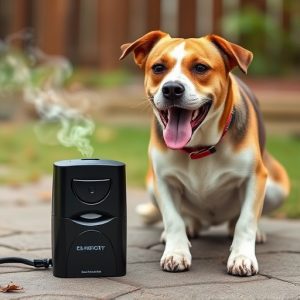Multi-Range Bark Control Devices: Training Tools for Aggressive Dogs
Understanding dog aggression stems from fear, anxiety or territorial instincts, requiring thoughtful…….
Understanding dog aggression stems from fear, anxiety or territorial instincts, requiring thoughtful use of bark control devices combining ultrasonic sounds, vibrations and spray repellents with positive reinforcement training. These devices, like dog repellent modes tailored to aggressive pets, offer safe solutions, allowing precise targeting of problematic areas while adjusting range and intensity as the pet's behavior improves.
“Unleash the power of controlled training with bark control devices, a game-changer in managing aggressive pets. This comprehensive guide explores the science behind these innovative tools and their role in curbing unwanted dog behavior. From understanding canine aggression to delving into the multi-range options, we uncover effective strategies for training.
Learn how different repellent modes can navigate a dog’s behavior, offering a safe and humanely tailored solution. Discover the key to transforming bustling, aggressive dogs into calm companions.”
- Understanding Dog Behavior and Aggression
- The Science Behind Bark Control Devices
- Exploring Multiple Range Options for Effective Training
Understanding Dog Behavior and Aggression
Understanding dog behavior is crucial when addressing aggression, especially in pets with multiple range bark control devices. Dogs communicate through a variety of vocalizations and body language, and what may seem like unprovoked aggression could be a response to fear, anxiety, or territorial instincts. Aggressive behavior often stems from underlying issues such as lack of socialization, past trauma, or breed-specific traits.
Identifying the root cause is key to successful management. Dog repellent modes in bark control devices should be used judiciously and in conjunction with positive reinforcement training. These repellents can help reduce unwanted barking by employing different stimuli, like sound, vibration, or spray, but they are most effective when combined with behavior modification techniques that teach dogs alternative responses and enhance their overall well-being.
The Science Behind Bark Control Devices
Bark control devices, also known as dog repellent systems, are designed to modify canine behavior by emitting specific signals or sounds that dogs find unpleasant. The science behind these devices involves understanding a dog’s sensory perception and using it to our advantage. Modern bark control technologies offer multiple modes of operation, catering to various barking issues, including aggression. These modes can range from ultrasonic sound waves to vibration and even spray-based repellents, each with its own level of intensity and effectiveness.
For aggressive pets, selecting the right mode is crucial. Ultrasonic devices emit high-frequency sounds that are inaudible to humans but irritating to dogs. This method is often a game-changer for addressing excessive barking without causing harm. Vibration modes can be particularly useful for dogs with a strong reaction to certain frequencies, while spray repellents offer an immediate solution for those who need quick desensitization. The key to success lies in identifying the trigger and choosing the most suitable repellent mode to manage aggressive behavior effectively.
Exploring Multiple Range Options for Effective Training
Training aggressive pets can be a challenging task, but exploring different bark control device modes can significantly enhance the process. These devices often offer multiple range options, allowing trainers to adapt their approach based on the pet’s behavior and environment. By adjusting the range, you can effectively target specific areas where barking occurs without causing discomfort or distress to the animal.
For instance, a higher range setting might be useful for managing excessive barking in larger outdoor spaces, while lower settings can be employed inside homes to correct unwanted vocalizations in close quarters. Dog repellent modes designed for aggressive pets often include adjustable sensitivity levels and customizable response intensity, providing a safe and precise training tool. This versatility ensures that the device can grow with your pet’s progress, catering to changing needs as behavior improves.
In light of the above discussions, it’s clear that bark control devices with multiple ranges offer a tailored and effective solution for managing aggressive pet behavior. By understanding dog behavior and utilizing the science behind these devices, owners can navigate various repellent modes to find the optimal setting for their pets’ training. This approach ensures a peaceful environment while addressing the root causes of aggression, ultimately fostering healthier canine-human interactions. For those dealing with challenging pets, exploring these advanced options can be a game-changer in creating a harmonious home.


